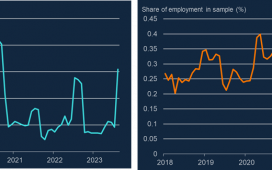One sales pitch of insurance salespeople has always been: “I don’t sell insurance, I sell peace of mind”. Regulators and central bankers are now spinning similar lines by emphasising the reassuring qualities of higher deposit insurance over its costs.
But localised banking turmoil does not justify mission creep by deposit insurance schemes. For commercial banks and their customers, the detriment would include further erosion of their agency within the financial system. Higher deposit insurance also would increase implicit subsidies to reckless bankers.
Current reforming zeal is the result of three regional bank failures in the US and of Credit Suisse. Runs on these institutions suggested to worrywarts that protection was too limited to fortify depositor confidence in a crisis, fuelling systemic risk.
The Federal Deposit Insurance Corporation has accordingly set out options for strengthening the financial safety net it operates. The body has favourably highlighted a possible increase from $250,000 to $2.5mn for day-to-day business accounts. The Bank of England, suffering what might be described as deposit insurance envy, is questioning whether its own ceiling of £85,000 is adequate. The European Commission wants to widen the scope of the EU scheme, but without lifting the cut-off from €100,000. Limited deposit insurance has obvious utility in forestalling bank runs and protecting the cash of people of slender means. The problem with extending it is that it increases moral hazard.
The theory is that blanket guarantees encourage some bankers to act recklessly. If they don’t have to worry so much about deposits fleeing, they can be more aggressive on loans. They can also woo depositors with unsustainably high interest rates.
The nature and extent of moral hazard is a subject for debates as ardent and inconclusive as those concerning transubstantiation or quantum string theory. But most sensible people believe it exists. “It is relevant to discuss moral hazard if you are seeking to significantly increase deposit insurance,” says Peter Tyler of UK Finance, an industry body.
Schemes typically impose the cost of covering the deposits of failed banks on prudent surviving lenders via an industry levy. In the short term, this will reduce profits and returns to shareholders. In the longer term, banks will recoup the cost from customers.
An important but underplayed aspect of moral hazard is that it can infect bank customers too. Suppose a Crazy Ed’s Savings Warehouse is paying double the interest of your stolid building society. You are more likely to move your money if you know you cannot lose it. As a necessary evil, deposit insurance caps therefore embody judgments about depositors. The generous US ceiling of $250,000 implies that a depositor with cash above the cap can afford to lose it and should probably have been more careful.
It follows that when the authorities increase protection for depositors they diminish the role of customers, banks and shareholders as allocators of capital. Markets do this job better than governments, because competition is baked in. And if you pitch deposit insurance too high, “everything becomes a deposit” as one former central banker says. Bankers will rewrite the terms of other investments to bring them under the umbrella.
The onus is therefore on regulators, central bankers and politicians to show that any extension of deposit guarantee schemes is necessary and proportionate. Recent bank failures do not cut it as proof. The US made extempore decisions to extend insurance to all deposits at Silicon Valley Bank and Signature Bank, but not at First Republic. The UK and Switzerland dealt with crises at SVB’s UK arm and at Credit Suisse by selling them to stronger rivals.
That appears to have forestalled contagion. Smarter, more selective regulatory tweaks — such as tighter controls on deposit concentration — may be advisable. The US should also take a close look at “reciprocal deposit networks”. These automatically spread large deposits across multiple institutions, none of which hold more than $250,000. Such networks may damage competition by propping up weak lenders. Sheila Bair, who ran the FDIC during the financial crisis, describes reciprocal deposits as “classic rent seeking”.
The case for higher deposit insurance is unproven. The bias of regulators in favour of more regulation also needs scrutiny. Their incentives are prone to skewing too, just like those of commercial bankers and insurance salespeople.





